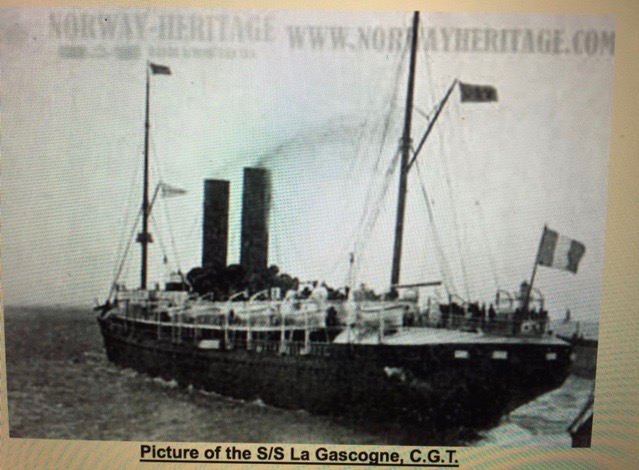My grandfather arrived to the United States, Ellis Island, NYC on August 5, 1906.
He left Aghios Petros as Παναγώτις Λυκούρας. He arrived in NYC as Panayiotis Lycouras. He was going to Lynn, MA. After he settled in Lynn, MA, he became Peter Lecouras – my grandfather.
Here is a portion of the “LIST OR MANIFEST FOR ALIEN PASSENGERS FOR THE U.S. IMMIGRATION OFFICE AT PORT OF ARRIVAL”

The name of the ship was La Gastogne. The ship departed from Le Havre, France, on July 23, 1906. The ship’s owner was Compagnie Générale Transatlantique, a French company.

Steamship companies like La Compagnie Generale Transatlantique generated volume of ship passengers by offering ticket packages. La Compaignie Generale Transatlantique offered to transport passengers by train from their homes to the company village in their port, Le Havre. They had agents throughout Europe, including Greece, which offered to transport immigrants by rail and steamship from their homes. The agent would work to arrange where a train would be available for a future passenger.
Παναγώτις Λυκούρας – my future grandfather – took advantage of this plan. Agios Petros did not have a railroad crossing at the time. My grandfather had to get to Tripolis to pick up a train. A cart and mule carried his baggage from Agios Petros to Tripoli. This is approximately 35 km – 22 miles. This trip, at the time anyway, required walking through villages, hills, and terrible terrain. Once arriving in Tripoli, my grandfather picked up a railroad trip to Le Havre, France. La Compaigne Generale Transatlantique ran a railway line with carriages tailored to the needs of emigrants.
Arrival in Le Havre was to the companies rooms allocated to future transport passengers. Once my grandfather, and others arrived at the company village, they would be prepared for the ocean voyage. They were examined by doctors, given an antiseptic bath and a short haircut, vaccinated, and quarantined several days before being placed on the steamship. Their luggage was fumigated with steam before boarding. This process destroyed many of their belongings.
Other steamship companies had similar processes – Cunard had a similar port in Liverpool, Holland-America in Rotterdam, and Hamburg-America in Hamburg.
These health requirements were driven by future inspections and potential problems. Steamship companies were liable for fines – approximately $100 per person around 1900 – for each passenger rejected by U. S. immigration. Beyond the fine for rejection, the steamships had to take the passengers back to Europe.
La Gastogne left Le Havre for NYC on July 23, 1906. Fourteen days later would be the arrival in NYC.
Here is an overview of what a trip was like below desks. —– Passengers, such as my grandfather, came on board poor and received minimal trip accommodations. There sleeping area and public space were down below. These passengers were identified as “steerage passengers” The quantity of these passengers were minimally 200 per ship, but some steamships had well above that.
The main portion below deck was a den – but called steerage. The size varied across the steamships, but generally steerage was about 40 feet long and about 12 feet wide. Instead of a ceiling, a hatchway opened on to the main deck.
The sleeping quarters are large compartments, accommodating as many as 300, or more, persons each. For assignment to these, passengers are divided into three classes: women without male escorts; men traveling alone; and families. Each class is housed in a separate compartment and the compartments are often in different parts of the area. As an example, a berth was 6 feet long and 2 feet wide and with 2 1/2 feet of space above it. This is all the space to which the steerage passenger can assert a definite right. Generally they consist of an iron framework containing a mattress, a pillow, or more often a life-preserver as a substitute, and a blanket. The mattress, and the pillow if there is one, is filled with straw or seaweed.
Given very limited space, with much filth and stench, and inadequate means of ventilation, the result was difficult and often created harmful health. Overtime improvements for steerage was made. Plus, required by law, wash rooms and lavatories, separate for men and for women, were added.
That is a brief overview of the sailing conditions for poor passengers – like my grandfather.
Roughly 9 days later, my grandfather arrived at Ellis Island on August 5, 1906.
